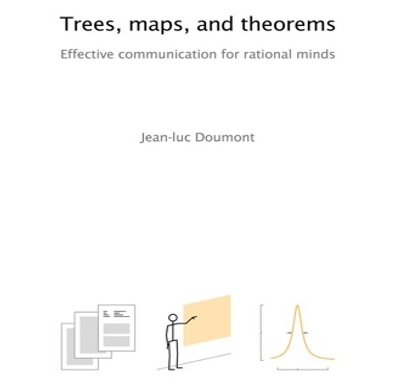Published on May 25, 2021
Finding guidance in Trees, Maps, and Theorems
Effective communication – Shortcomings in scientific writing

Engineers are known for their technical skills, critical thinking, and problem solving. What engineers are not known for is the ability to speak and write well. This stereotype could be due to the intense coursework and hours spent studying, not making room for them to develop communication and soft skills. However, as engineers, they need to be able to sell their ideas by being able to prepare and deliver a clear, concise, and convincing message. Clear written content is one major short coming in scientific writing, typically viewed as a peripheral skill and not necessarily a core skill. It is important for engineers to craft clear, concise documents and presentation materials that would step into the mindset of their audiences/readers.
One of the highly recommended books to mend these shortcomings is called Trees, Maps, and Theorems: Effective Communcation for Rational Minds by Jean-Luc Doumont, who, after earning a PhD in Engineering, wanted to explore aspects of better communication in engineering and research. This book has five main components: fundamentals, effective written documents, oral presentations, graphical displays and applications.
Five main components in Trees, Maps and Theorems:
- Fundamentals: offers a minimal set of universal principles which equips readers for most challenges of professional communication
- Effective written documents: provides five steps to proceed from scratch to a complete document by planning, designing, drafting, formatting, and revising the document
- Effective oral presentations: outlines planning the presentation, designing it, creating the slides, delivering the presentation, and answering questions
- Effective graphical displays: discusses how to plan, design, and construct optimal graphs, and how to draft a caption
- Applications: overviews the five common types of documents, namely sets of instructions, e-mail, Web sites, meeting reports, and scientific posters
Overcoming writing apprehension as an engineer
As a student in engineering, I have never had the most effective communication skills. Starting earlier in my childhood, I lacked the understanding of how-to comprehend what principles and components come into being a good writer and speaker. When I had to write,
I would often be afraid and have anxiety at the thought of approaching the task. I would either not know where to start or would be afraid of precautions due to my lack of writing skills. This all changed in college for me when I joined Dr. Heather K. Hunt’s research laboratory and took a few of her engineering classes. Dr. Hunt, a professor in the department of Biomedical, Biological, and Chemical Engineering has used the book Trees, Maps and Theorems as a guide for students in her writing intensive courses and in her research laboratory.
I had the pleasure of interviewing Dr. Hunt, to gain a perspective of why she is an advocate of Dr. Doumont’s teaching and how she has applied it to her teaching philosophy. Dr. Hunt first heard of this book as a graduate student at Caltech when she went to Dr. Jean-Luc Doumont’s presentation on effective communication. His philosophy is what made this topic groundbreaking with a new perspective in engineering; Dr. Hunt was so intrigued by his ideas of effective communication, that she wanted to learn how to apply it herself. She stated how difficult it is to learn certain subjects but listening to Doumont made “topics coming from engineering perspective that made everything click like it hasn’t before.” She stated that her favorite aspect of the Trees, Maps, and Theorem book is that, unlike other effective communications textbooks that are lengthy and wordy, it is concise with very few pages and focuses on written documents, oral presentations and graphical displays.
Being introduced to Trees, Maps, and Theorems helped me understand the basic principles and guidelines for communicating effectively. I was able to learn how to develop concise but detailed outlines, prepare presentations and present in manners that were understandable to a wide audience.
My perspective of how I looked at writing changed due to the non-traditional layout of the chapters. Each topic was presented in a visual structure to help me conceptualize concept maps, charts, example posters, abstracts and writing samples that were broken into small sections with a brief explanation on what each component should encompass. Dr. Doumont helped me change the way I see writing; it made it easier for me to take those techniques and apply it to aspects of my engineering career (ex: research manuscripts, poster presentations and PowerPoint slides.)


*Figure 1 is a poster I created before learning about the book Trees, Maps, Theorems and figure 2 is how graphical organization changed after learning about the best practices in the Trees, Maps, and Theorems.